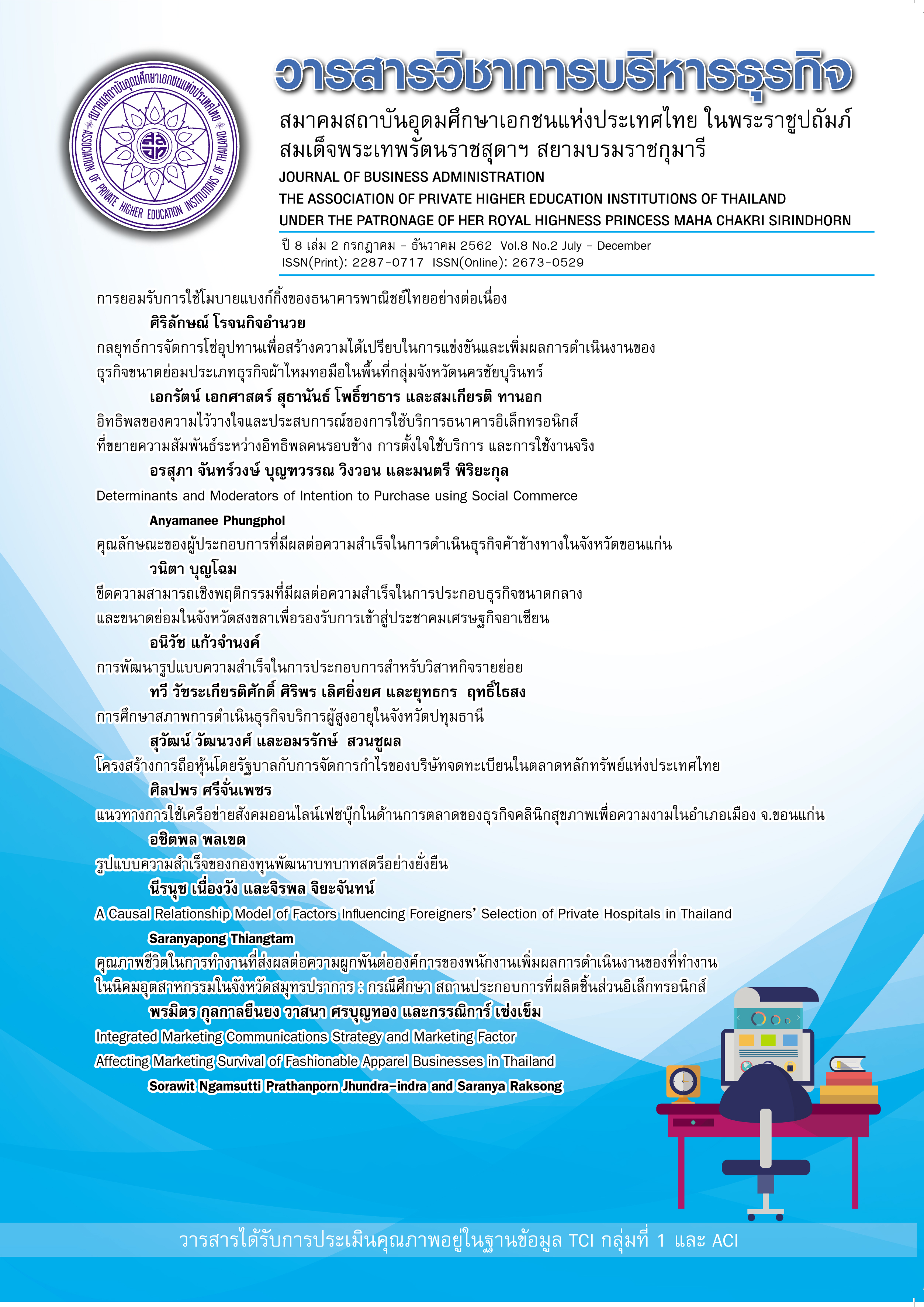รูปแบบความสำเร็จของกองทุนพัฒนาบทบาทสตรีอย่างยั่งยืน
คำสำคัญ:
รูปแบบของความสำเร็จ, กองทุนพัฒนาบทบาทสตรี, ความยั่งยืนบทคัดย่อ
การวิจัยครั้งนี้มีวัตถุประสงค์ศึกษารูปแบบความสำเร็จของกองทุนพัฒนาบทบาทสตรีอย่างยั่งยืน ศึกษารูปแบบความสำเร็จของกองทุนประกอบด้วย วงจรคุณภาพ PDCA และคุณลักษณะของผู้บริหารกองทุนที่ส่งผลต่อความยั่งยืนของกองทุนพัฒนาบทบาทสตรี กลุ่มประชากรที่ใช้ในการศึกษาครั้งนี้ คือผู้บริหาร และสมาชิกกองทุนพัฒนาบทบาทสตรีในเขตภาคกลางจำนวน 25 จังหวัด การวิจัยครั้งนี้เป็นการวิจัยผสมผสาน การวิจัยเชิงคุณภาพใช้แบบสัมภาษณ์เชิงลึกผู้บริหาร จำนวน 19 คน เพื่อยื่นยันกรอบแนวคิดทฤษฎีที่พัฒนาขึ้นจากการทบทวนวรรณกรรมที่เกี่ยวข้อง และการวิจัยเชิงปริมาณใช้แบบสอบถามสมาชิกจำนวน 252 คน สถิติที่ใช้วิเคราะห์ข้อมูล คือ ค่าร้อยละ ค่าเฉลี่ย ส่วนเบี่ยงเบนมาตรฐาน และการวิเคราะห์ใช้โมดลสมการโครงสร้าง (Structural Equation Modeling : SEM)
ผลการศึกษาพบว่า รูปแบบความสำเร็จของกองทุนพัฒนาบทบาทสตรีอย่างยั่งยืน โมเดลมีค่า P-value=0.543, =46.27, df=48, /df=0.96 ซึ่งต่ำกว่า 2 แสดงว่า รูปแบบความสำเร็จของกองทุนพัฒนาบทบาทสตรีอย่างยั่งยืนมีความเหมาะสมของโมเดล นอกจากนี้ยังมีค่า GFI=0.97, AGFI=0.94, CFI=1.00, SRMR=0.026 RMSEA=0.000 ค่าน้ำหนักองค์ประกอบปัจจัยด้าน PDCA (β=0.74) ประกอบด้วยการวางแผน การปฏิบัติ ประเมิน และปรับปรุง และคุณลักษณะของผู้บริหาร(β=0.10) ประกอบด้วยวิสัยทัศน์ ธรรมาภิบาล การทำงานเป็นทีม การแก้ไขปัญหา การสื่อสาร และความเชื่อมั่นในตนเอง ทุกตัวมีค่าเป็นบวกส่งผลและมีอิทธิพลทางตรงต่อรูปแบบความสำเร็จของกองทุนพัฒนาบาทสตรีอย่างยั่งยืนประกอบด้วยเศรษฐกิจ สังคม สิ่งแวดล้อม และปรัชญาเศรษฐกิจพอเพียง อย่างมีนัยสำคัญทางสถิติระดับ 0.01 รูปแบบความสำเร็จของกองทุนพัฒนาบทบาสตรีสำเร็จได้นั้นขึ้นอยู่กับสมาชิก และผู้บริหารกองทุน ที่จะขับเคลื่อนปัจจัยทางด้าน PDCA และคุณลักษณะของผู้บริหารมีผลส่งเสริมให้เกิดรูปแบบความสำเร็จของกองทุนพัฒนาบทบาสตรีอย่างยั่งยืน
เอกสารอ้างอิง
Avolio, B. J., & Bass, B. M. (1999). Transformational leadership, charisma and beyond. In J.G Hunt et al. (Eds.). Emerging Leadership vistas, 29-50. Lexington Books.
Atkisson, A. (2013). Sustainability is for Everyone. 5ed. A Sustainability Transformation Publication, Retrieved October 15, 2015, from www.CforST.com.
Bennis, W. G. (1985). “Leadership Effectiveness of Wisconsin Superintendents,” Dissertation Abstracts International. 47(2), 42-49–A.
Bhumibol Adulyadej, His Majesty King. (1999). Sufficiencssue August 2010, (Office of the Chaipattana Foundation, Amarin Privilege/Premises and remises Co.,Ltd.
Bollen, K. A. (1989). Structural Equationa with Latent Variables. New York: Wliey.
Bryman, A. (2007). Charismatic and Leadership in Organizations. London: SAGE Publications.
Conger, J. A., & Kanungo, R.N. (2001). A behavioral attribute measure of Charismatic leadership in organizations. Paper presented at the Academy of Management Meetings, San Francisco.
Cronbach, Lee Joseph. (1970). Essentials of Psychological testing. New York : Harper and Row.
Davis, K., & Soctt,W. (2003). The Relationship among Leadership Styles Work-Related Cultural Values and Organizational Outcomes in Higher Educational Institutions in Thailand. D.B.A. in Business Administration. Nova Southeastern University: USA.
Diamantopoulos, A., & Siguaw, A. D. (2000). Introducing LISREL: A guide for the uninitiated. Sage Publications: London.
DuBrin, J. A. (1998). Leadership Research Findings Practice and Skills. Houghton: Mifflin company.
Elkington, J. (1999). Cannibals with Forks: The Triple Bottom Line of 21st Century Business. Capstone Publishing Ltd, Oxford : HEC Paris.
Hair, J. F., Black, W. C., Babin, B. J., & Anderson, R. E. (2010). Multivariate Data Analysis, (7th ed.). NJ: Prentice Hall.
Howell, J. M., & Avolio, B. J. (1992). The Ethics of Chrismatic Leadership: Submission or liberation Executive, 6(2), 43-52.
Hu & Bentler. (1999). Cutoff criteria for fit indexes in covariance structure analysis: Coventional criteria versus new alternatives, Structural Equation Modeling, 6(1), 1-55.
Inaeym, T., Makeraraphan, K., & Chyachantana, C. (2017). The Developing of Servant Leadership for The Management Lubricant Business in Thailand. Journal of MCH Social Science Review, 6(2)(Extra), 281-292.
Inwang, K., Peechaol, C., Jindamanee, T., & Somboonpol, U. (2018). An academic leadership developmetal model by knowledge management of executives from private universities. Journal of Business Administration, 6(1), 114-129.
Kaplan, D. (2001). Structural equation Modeling. Sage Publication, Thosand Oaks, Caledonia.
Kethanom, T. (2014). The Development of Leadership Indicators of Dean of Private Higher Education Institutes in Bangkok. Burapha University Journal, 25(1), 125-137.
Kume, H. (1996). TQM Promotion Guide Book. Japanese Standards Association. Tokyo.
Lussier, R. N., & Achua, C. F. (2009). Leadership: Theory, application, skill Development. Cincinnati, Ohio: South-Western College Publishing.
Lindeman,R.H., Merenda,P.F., & Gold,R.Z.(1980) Introduction to bivariate and multi variateanalysis.Glenview.IL: Scott, Foresman, and Company.
Nuengwang, N. (2015). Integrating The Guiding Philosophy of Sufficiency economy to Civilization in the Lifestyle of the people in T. Huaykrajao A. Huaykrajao Karnjanaburi. Conference proceedings and presentation of national research. 5th. Sustainability Research for Sustainable Development (pp.205-214). Pathumthani: Western University.
Paitipunt, K. (2012). A Structural Equation Model of Creative Leadership for Vocational College Administors. Doctor of Philosopy. Khun Kaew: Khun Kaew University.
Panitamai, V. (2006). Change leader. Bangkok: Thana Press and Graphic.
Santiwong, T. (2007). Organization Behavior: A Study of Organizational Management behavior. (5th ed.). Bangkok: Thai Wattana Panich.
Soodkeeree,J. (2015). Sustainable Community Development Model. Journal of Southern Technology, 8(1), 9-16
Stogdill, M.R. (1985). Hanbook of leadership. New York: Free Press.
Suksawang, P. (2014). The Basics of Structural equation modeling. Princess of Naradhinas University Journal, 6(2), 136-145.
Teugfung, R. (2013). The Analysis of MIMIC model: The using of LISREL Program Trial Version of Research. Journal of The Association of Researchers, 18(2), 128-140.
Thong BoonChu, C. (2014). Sustainable Organization from Philosophy of Sufficiency Economy and Total Quality Management. Journal of Management Science, 1(1),13-27.
Tozawa, K. (1986). Impurity Control. New York: Haper & Row.
Unthavatanapaibul, K., Vongyuttakrai, P., & Taewattan,T. (2015). Development of Promotion Career Model Related to Sufficiency Economy. Journal of Industrial Eduction,9(1), 34-45.
Wachirapon, C., Chaiyagan, P., Banchirdit, S., & Homying, W. (2014). Attributes of the Modern Leadership with Professional Management Competencies of Municipal Clerks in the Central Region. Journal of the Association of Researchers, 19(1), 86-96.
Wasee, P. (1999). Sufficiency Economy and Civil Society The way to revive the economy and society. Bangkok: Column “Moo Shaw Ban” (Book Title).
Women Empowerment Fund. (2012). Action Plan for Women Empowerment Fund 2010. Retrieved October 2, 2015, Form http: //www.womenfund.in.th/about-womenfund/ Action-plan.htm.
Yukl, G. A. (2006). Leadership in Organizations (4th ed.). New York: Prentice-Hall, Inc.
ดาวน์โหลด
เผยแพร่แล้ว
รูปแบบการอ้างอิง
ฉบับ
ประเภทบทความ
สัญญาอนุญาต
บทความที่ลงตีพิมพ์ในวารสารวิชาการบริหารธุรกิจ สมาคมสถาบันอุดมศึกษาเอกชนแห่งประเทศไทยต้องเป็นบทความที่ไม่เคยได้รับการตีพิมพ์เผยแพร่ หรืออยู่ระหว่างการพิจารณาตีพิมพ์ในวารสารอื่นๆ การละเมิดลิขสิทธิ์เป็นความรับผิดชอบของผู้ส่งบทความโดยตรง


